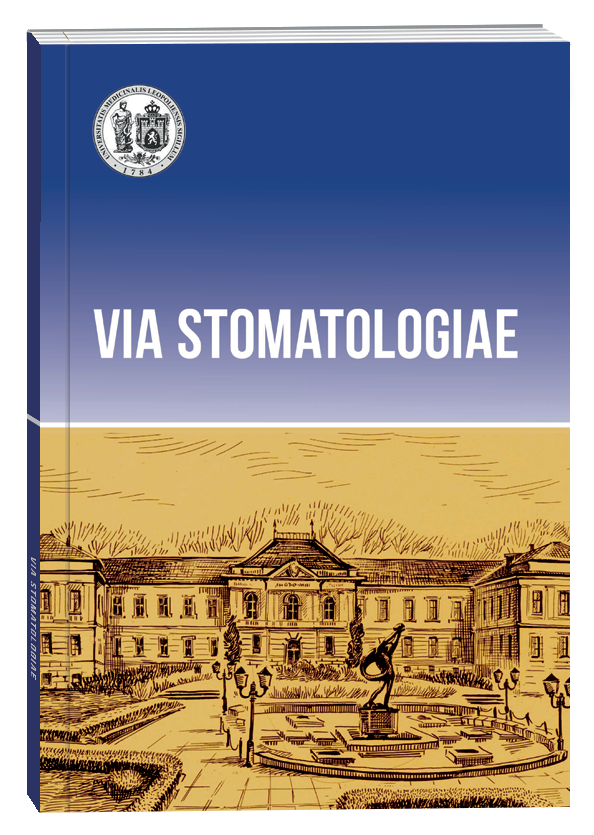РЕЗУЛЬТАТИ ЕКСПЕРИМЕНТАЛЬНО-КЛІНІЧНОГО ДОСЛІДЖЕННЯ СТАНУ ТКАНИННОГО ІНТЕРФЕЙСУ ЕНДООСАЛЬНИХ ІМПЛАНТАТІВ ПРИ АКСІАЛЬНОМУ ТА ПАРААКСІАЛЬНОМУ ФУНКЦІОНАЛЬНОМУ НАВАНТАЖЕННІ (ОГЛЯД СУЧАСНОГО СТАНУ ПРОБЛЕМИ)
DOI:
https://doi.org/10.32782/3041-1394.2024-1.1Ключові слова:
дентальний імплантат, інтерфейс «імплантат – кісткова тканина», аксіальне та неаксіальне функціональне навантаження імплантатівАнотація
У сучасних діагностично-лікувальних протоколах проведення дентальної імплантації акцентується увага на врахуванні як морфологічних, так і функціональних факторів для досягнення довготривалої клінічної результативності цієї технології лікування. Відсутність забезпечення функціонально орієнтованого позиціонування дентальних імплантатів (ДІ) і протезних конструкцій призводить у клінічній практиці до частих ускладнень при хірургічних втручаннях, які важко піддаються корекції, а результати застосованого протезування негативно змінюють функціональну витривалість периімплантного тканинного оточення з ранньою експлантацією ДІ. З огляду на це багато зусиль фахівців спрямовано на експериментальне дослідження особливостей розподілу функціонального навантаження ДІ в оточуючій кістковій тканині зі спробою екстраполяції отриманих даних у клінічну практику для оптимізації розташування застосовуваних при цьому протезних конструкцій. Проведені дослідження дисфункціонального впливу навантаження в ділянках похилих площин оклюзійних поверхонь протезних конструкцій довели зростання концентрованої горизонтальної складової навантаження ДІ, внаслідок чого збільшуються компресійні та розтягуючі деформаційні сили, які спричинюють резорбцію альвеолярної кісткової тканини щелеп. Встановлено, що підвищення векторів бічних навантажень на межі кістка-імплантат виникає при імплантації безпосередньо після видалення зубів. При цьому репарація кісткової тканини призводить до втрати маргінального рівня і. У результаті цього коронки на ДІ виготовляються більшими за коронки наявних зубів, що вторинно може зумовити зростання шкідливого впливу деформаційних векторів. У зв’язку з наявністю контраверсійних тлумачень щодо результатів тривалого впливу функціонального навантаження ДІ на стан інтерфейсу периімплантних тканин констатується необхідність проведення сучасного експериментального морфологічного, рентгенографічного та гістоморфометричного аналізу показників інтерфейсу ДІ, розташованих в аксіальному та парааксіальному положеннях по периметру контакту з оточуючою кісткою.
Посилання
Flemming I.Influence of forces on peri-implant bone (2006). Clinical Oral Implants Research 17 (Suppl. 2), 8–18.
Degidi M., Scarano A., Piattelli M., Perrotti V., Piattelli A. (2005). Bone remodeling in immediately loaded and unloaded titanium dental implants: a histologic and histomorphometric study in humans. Journal of Oral Implantology, 31, 18–24.
Manea A., Bran S., Cristian D., Rotaru H., Barbur I, Crisan B., Armencea G., Onisor F., Lazar M., Ostas D., Baciut M., Vacaras S., Mitre I., Liana C., Muresan O., Roman R., Baciut G. (2019). Principles of biomechanics in oral implantology, Medecine and pharmacy reports., 92 (Suppl.), 3, 14–19.
Misch C.E., Suzuki J.B., Misch-Dietsh F.M., Bidez M.W. (2005). A positive correlation between occlusal trauma and peri-implant bone loss: literature support. Implant Dentistry, 14, 108–116.
Kitamura E., Stegaroiu R., Nomura S. & Miyakawa O. (2004). Biomechanical aspects of marginal bone resorption around osseointegrated implants: considerations based on a three-dimensional finite element analysis. Clinical Oral Implants Research, 15, 401–412.
Watzak G., Zechner W., Ulm C., Tangl S., Tepper, G. & Watzek G. (2005). Histologic and histomorphometric analysis of three types of dental implants following 18 months of occlusal loading: a preliminary study in baboons. Clinical Oral Implants Research, 16, 408–416.
Zechner W., Trinkl N., Watzak G., Busenlechner D., Tepper G., Haas R., Watzek G. (2004). Radiologic follow-up of peri-implant bone loss around machine-surfaced and roughsurfaced interforaminal implants in the mandible functionally loaded for 3 to 7 years. International Journal of Oral & Maxillofacial Implants, 1(19), 216–221.
Roberts W.E., Turley P.K., Brezniak N. & Fielder P.J. (1987). Implants: bone physiology and metabolism. Journal of the California Dental Association, 15, 54–61.
Podaropoulos L., Veis A.A., Trisi P.; Papadimitriou S., Alexandridis C., Kalyvas D. (2016). Bone reactions around dental implants subjected to progressive static load: An experimental study in dogs. Clin. Oral Implants Res., 27(3), 910–917.
Duyck J., Vrielinck,L., Lambrichts I., Abe Y., Schepers S., Politis C. Naert I. (2005). Biologic response of immediately versus delayed loaded implants supporting ill-fitting prostheses: an animal study. Clinical Implant Dentistry and Related Research, 7, 150–158.
Quinlan P., Nummikoski P., Schenk R., Cagna D., Mellonig J., Higginbottom, F., Lang K., Buser D. Cochran D. (2005). Immediate and early loading of SLA ITI single-tooth implants: an in vivo study. International Journal of Oral & Maxillofacial Implants, 20, 360–370.
Buchter A., Wiechmann D., Koerdt S., Wiesmann H.P., Piffko J. Meyer U. (2005). Load-related implant reaction of mini-implants used for orthodontic anchorage. Clinical Oral Implants Research, 16, 473–479.
Duyck J., Vandamme K., Geris L., Van Oosterwyck H., De Cooman M., Vander Sloten J., Puers R., Naert I. (2006). The influence of micro-motion on the tissue differentiation around immediately loaded cylindrical turned titanium implants. Archives of Oral Biology, 51, 1–9.
Вовк Ю.В., Вовк В.Ю. (2017). Експериментальне дослідження стану кісткової тканини при впливі тривалого функціонального навантаження на дентальні імплантати, уведені з різностороннім нахилом. Новини стоматології, 2 (91), 62–70.
Decker AМ, Sheridan R., Lin G.H., Sutthiboonyapan P., Carroll W., Wang H.L. (2015). Prognosis System for Periimplant Diseases. Implant Dentistry, 24(4), 416–421.
Roberts W.E., Smith R.K., Zilberman Y., Mozsary P.G., Smith R.S. (1984). Osseous adaptation continuous loading of rigid endosseous implants. American Journal of Orthodontics and Dentofacial Orthopedics, 86, 95–111.
Stahl, E., Keilig, L., Abdelgader, I., Jager, A., Bouraue, l.C. (2009). Numerical analyses of biomechanical behaviour of various orthodontic anchorage implants. Journal of Orofacial Orthopedics, 70, 115–127.
Wilmes B., Su Y.Y., Drescher D. (2008). Insertion angle impact on primary stability of orthodontic mini-implants. Angle Orthodontics, 1(78), 1065–1070.
van Staden R.C., Guan H., Johnson N.W., Loo Y.C., Meredith, N. (2008). Step-wise analysis of the dental implant insertion process using the finite element technique. Clinical Oral Implants Research, 19, 303–313.
Chrcanovic B. R., Albrektsson T., Wennerberg A. (2015). Tilted versus axially placed dental implants: A meta-analysis Review Journal of Dentistry, 43(2), 149–170.
Vidyasagar, L. Apse, P. (2003). Biological response to dental implant loading/overloading.Implant overloading: empiricism or science? Stomatologija, 5(3), 83–89.
Roberts W.E., Smith R.K., Zilberman,Y., Mozsary P.G., Smith R.S. (1984). Osseous adaptation continuous loading of rigid endosseous implants. American Journal of Orthodontics and Dentofacial Orthopedics, 86, 95–111.
Page H.L. (1952). The occlusal curve.Dental digest., 3, 19–22.
Orthlieb J.-D. (1997). The curve Spee: understanding the sagittal organization of mandibular teeth. The Journal of Craniomandibular Practice, 4, 333–34.
Ré J.-Ph., Foti B., Glise J.-M., Orthlieb J.-D. (2015). Optimal placement of the two anterior implants for the mandibular All-on-4 concept J. Prosthet Dent., 114, 17–21.
Krekmanov L., Kahn M., Rangert B., Lindstrom H. (2000). Tilting of posterior mandibular and maxillary implants of improved prosthesis support. Int. J. Oral. Maxillofac. Implants, 15(2), 405–414.
Sebaoun J.D., Kantarci A., Turner J.W., Carvalho R.S., Van Dyke T.E., Ferguson D.J. (2008). Modeling of trabecular bone and lamina dura following selective alveolar decortication in rats. J. Periodontol., 79(9), 1679–1688.
Chun H.J., Shin H.S., Han C.H., Lee S.H. (2006). Influence of implant abutment type on stress distribution in bone under various loading conditions using finite element analysis. Int J Oral Maxillofac Implants, 21(2), 195–202.
Calandriello R, Tomatis M. (2005). Simplified treatment of the atrophic posterior maxilla via immediate/early function and tilted implants: a prospective 1-year clinical study. Clinical Implant Dentistry and Related Research, 7, 1–12.
Capelli M, Zuffetti F, Del Fabbro M, Testori T. (2007). Immediate rehabilitation of the completely edentulous jaw with fixed prostheses supported by either upright or tilted implants: a multicenter clinical study. International Journal of Oral and Maxillofacial Implants, 22, 639–644.
Malo ́ P, de Arau ́jo Nobre M, Lopes A. (2007). The use of computer-guided flapless implant surgery and four implants placed in immediate function to support a fixed denture: preliminary results after a mean follow-up period of thirteen months. Journal of Prosthetic Dentistry, 97, 26–34.
Agliardi EL, Francetti L, Romeo D, Taschieri S, Del Fabbro M. (2021). Immediate loading in the fully edentulous maxilla without bone grafting: the V-II-V technique. Minerva Stomatologica, 57(2), 59–63.
Francetti L, Agliardi E, Testori T, Romeo D, Taschieri S, Del Fabbro M. (2008). Immediate rehabilitation of the mandible with fixed full prosthesis supported by axial and tilted implants: interim results of a single cohort prospective study. Clinical Implant Dentistry and Related Research, 10(2), 255–263.
Tealdo T., Bevilacqua M., Pera F., Menini M., Ravera G., Drago C. (2008). Immediate function with fixed implant-supported maxillary dentures: a 12-month pilot study. Journal of Prosthetic Dentistry, 99, 351–360.
Testori T., Del Fabbro M., Capelli M., Zuffetti F., Francetti L., Weinstein R. (2010). Immediate occlusal loading and tilted implants for the rehabilitation of the atrophic edentulous maxilla: 1-year interim results of a multicenter prospective study. Clinical Oral Implants Research, 19(2), 227–232.
Chrcanovic B. R., Albrektsson T., Wennerberg A. (2015). Bruxism and Dental Implants: A Meta-Analysis, 243(5), 505–516.
Krekmanov L., Kahn M., Rangert B., Lindström H. (2000). Tilting of posterior mandibular and maxillary implants for improved prosthesis support. Oral Maxillofac Implants, 15(3), 405–414.
Calandriello R, Tomatis M. (2005). Simplified treatment of the atrophic posterior maxilla via immediate/early function and tilted implants: a prospective 1-year clinical study. Clinical Implant Dentistry and Related Research, 7, 1–12.
Koutouzis T., Wennstrom J.L. (2007). Bone level changes at axial- and non-axial-positioned implants supporting fixed partial dentures. A 5-year retrospective longitudinal study. Clinical Oral Implants Research, 18, 585–590.
Kawasaki T., Komatsu K., Tsuchiya R. (2011). Tilted placement of tapered implants using a modified surgical template. Journal of Oral and Maxillofacial Surgery, 69, 1642–1650.
Cavalli N., Barbaro B., Spasari D., Azzola F., Ciatti A., Francetti L. (2012). Tilted implants for full-arch rehabilitations in completely edentulous maxilla: a retrospective study. International Journal of Dentistry Article, ID 180379, 6.







